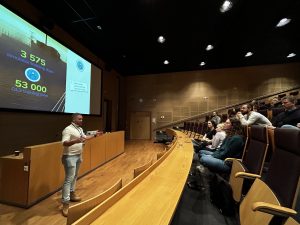With construction starting in 2005 and regular electricity production commencing only now, in March 2023, it is obvious that this has been quite a journey. Now, the third nuclear power plant at Olkiluoto is nearing its Big Moment – the start of commercial operation.
Hannu Reinvall, Head of Power Plant Engineering, knows Olkiluoto’s OL3 Project pretty much as thoroughly as is humanly possible. After all, it is what he has been working on since 2004. At that time, the actual construction work for the project had not even started.
– In other words, I was not yet involved in the project during the call for tenders but came in quite soon after that, Hannu Reinvall explains.
Over the course of nearly 20 years, he has had many different duties in the gigantic project.
– I started here as a material and welding specialist and have since worked as a team manager, operative development manager, office manager, plant engineering manager and eventually as deputy director of the OL3 project, Mr. Reinvall tells us.
Eyes on the finish line
Building a nuclear power plant is clearly all about endurance, so comparing it to a marathon is more than appropriate: if the OL3 project were a marathon race – with a total distance of 42.195 km – we would be right near the end.
– We would have passed the 42 km mark by this point, Hannu Reinvall says.
However, he is quick to add that there is still work to do after the PTO day, i.e. the start of regular electricity production.
– We have our work cut out for us with inventories of spare parts, for example. I am also certain that, during the first few years, we will encounter various minor things that need tweaking, just as with the OL1 and OL2 plant units back in the day.
Mr. Reinvall described his experiences of working on the project today in the Olkiluoto Visitor Centre’s auditorium. His audience comprised 17 participants from the Nordic Nuclear Trainee Program – relatively new nuclear professionals from four different companies in Finland and Sweden.

What we learned
In his presentation, Mr. Reinvall mainly focused on OL3, but he also discussed the other EPR projects in progress around the world. The commissioning of new state-of-the-art technology has been challenging for all industry professionals.
– This is one of those ‘lessons learned’ type talks, Mr. Reinvall said.
In particular, Reinvall emphasised the importance of thorough preparation in everything you do.
– A nuclear power plant amplifies the significance of the completion of planning due to the immense scale of the project and how complex everything is.
This, in turn, poses challenges in scheduling a project that is made up of so many different areas. Carefully planned schedules are important, and it is at least equally important to be able to follow them.
– A smaller project allows for starting certain project stages in tandem, if necessary, but in a project of this magnitude, starting certain stages too early often does more harm than good.
Experience and communication
Another finding is that it is very important to ensure good and fluent collaboration and communication between all stakeholders, including contractors, the plant supplier, owner and the authorities.
– As I have said, this is a very complex project, and this includes not only the technology but also legal and cultural complexity, for example, Mr. Reinvall points out. A complex operating environment emphasises the importance of collaboration and communication.
The new design solutions utilised contributed to the challenges with the OL3 project.
– Of course, building a completely new type of plant is a challenge in itself.
On several occasions, the problems and challenges faced during the project concerned the new design solutions. It can also be stated that everyone involved could have used people with previous experience from nuclear power plant construction projects.
– This would have made it more effective to utilise the lessons learned from earlier nuclear construction projects.
Having said that, people like this were quite hard to find as European nuclear power plant projects of this scale had not been built in years.
Now, thanks to the soon-ending project, the Nordic countries have plenty of this kind of experience.
